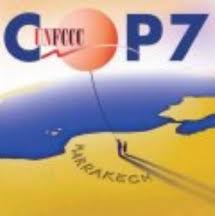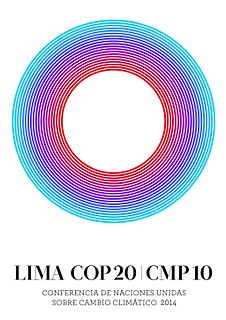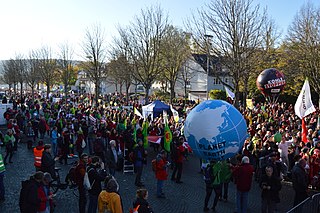 W
WThe United Nations Climate Change Conferences are yearly conferences held in the framework of the United Nations Framework Convention on Climate Change (UNFCCC). They serve as the formal meeting of the UNFCCC Parties to assess progress in dealing with climate change, and beginning in the mid-1990s, to negotiate the Kyoto Protocol to establish legally binding obligations for developed countries to reduce their greenhouse gas emissions. From 2005 the Conferences have also served as the "Conference of the Parties Serving as the Meeting of Parties to the Kyoto Protocol" (CMP); also parties to the Convention that are not parties to the Protocol can participate in Protocol-related meetings as observers. From 2011 the meetings have also been used to negotiate the Paris Agreement as part of the Durban platform activities until its conclusion in 2015, which created a general path towards climate action.
 W
WThe 1998 United Nations Climate Change Conference took place in November 1998 in Buenos Aires, Argentina. The conference included the 4th Conference of the Parties (COP4) to the United Nations Framework Convention on Climate Change (UNFCCC). It had been expected that the remaining issues unresolved in Kyoto would be finalized at this meeting. However, the complexity and difficulty of finding agreement on these issues proved insurmountable, and instead the parties adopted a 2-year "Plan of Action" to advance efforts and to devise mechanisms for implementing the Kyoto Protocol, to be completed by 2000. During the conference, Argentina and Kazakhstan expressed their commitment to take on the greenhouse gas emissions reduction obligation, the first two non-Annex countries to do so.
 W
WThe 2001 United Nations Climate Change Conference took place from October 29 to November 10, 2001 in Marrakech, Morocco. The conference included the 7th Conference of the Parties (COP7) to the United Nations Framework Convention on Climate Change (UNFCCC). The negotiators wrapped up the work on the Buenos Aires Plan of Action, finalizing most of the operational details and setting the stage for nations to ratify the Kyoto Protocol. The completed package of decisions is known as the Marrakech Accords. The United States delegation maintained its observer role, declining to participate actively in the negotiations. Other parties continued to express hope that the United States would re-engage in the process at some point and worked to achieve ratification of the Kyoto Protocol by the requisite number of countries to bring it into force. The date of the World Summit on Sustainable Development was put forward as a target to bring the Kyoto Protocol into force. The World Summit on Sustainable Development (WSSD) was to be held in Johannesburg, South Africa.
 W
WThe 2002 United Nations Climate Change Conference took place from 23 October – 1 November 2002, in New Delhi, India. The conference included the 8th Conference of the Parties (COP8) to the United Nations Framework Convention on Climate Change (UNFCCC). The conference adopted the Delhi Ministerial Declaration that, amongst others, called for efforts by developed countries to transfer technology and minimize the impact of climate change on developing countries. It is also approved the New Delhi work programme on Article 6 of the Convention. The COP8 was marked by Russia's hesitation, stating that it needed more time to think it over. The Kyoto Protocol could enter into force once it was ratified by 55 countries, including countries responsible for 55 per cent of the developed world's 1990 carbon dioxide emissions. With the United States and Australia refusing ratification, Russia's agreement was required to meet the ratification criteria and therefore Russia could delay the process.
 W
WThe 2003 United Nations Climate Change Conference took place between 1–12 December 2003 in Milan, Italy. The conference included the 9th Conference of the Parties (COP9) to the United Nations Framework Convention on Climate Change (UNFCCC). The parties agreed to use the Adaptation Fund established at COP7 in 2001 primarily in supporting developing countries better adapt to climate change. The fund would also be used for capacity-building through technology transfer. At the conference, the parties also agreed to review the first national reports submitted by 110 non-Annex I countries.
 W
WThe 2004 United Nations Climate Change Conference took place between December 6 and December 17, 2004 in Buenos Aires, Argentina. The conference included the 10th Conference of the Parties (COP10) to the United Nations Framework Convention on Climate Change (UNFCCC).
 W
WThe 2005 United Nations Climate Change Conference took place between November 28 and December 9, 2005, in Montreal, Quebec, Canada. The conference included the 11th Conference of the Parties (COP11) to the United Nations Framework Convention on Climate Change (UNFCCC), and was the first Meeting of the Parties (MOP1) to the Kyoto Protocol since their initial meeting in Kyoto in 1997. It was one of the largest intergovernmental conferences on climate change ever. The event marked the entry into force of the Kyoto Protocol on 16 February 2005. Hosting more than 10,000 delegates, it was one of Canada's largest international events ever and the largest gathering in Montreal since Expo 67. The Montreal Action Plan was an agreement to "extend the life of the Kyoto Protocol beyond its 2012 expiration date and negotiate deeper cuts in greenhouse gas emissions" by starting negotiations, without delay on an extension of the protocol. Canada's environment minister, at the time, Stéphane Dion, said the agreement provides a "map for the future".
 W
WThe 2006 United Nations Climate Change Conference took place between November 6 and 17, 2006 in Nairobi, Kenya. The conference included the 12th Conference of the Parties to the UN Framework Convention on Climate Change (UNFCCC) (COP12) and the second Meeting of the Parties to the Kyoto Protocol (MOP2).
 W
WThe 2007 United Nations Climate Change Conference took place at the Bali International Conference Centre, Nusa Dua, in Bali, Indonesia, between December 3 and December 15, 2007. Representatives from over 180 countries attended, together with observers from intergovernmental and nongovernmental organizations. The conference encompassed meetings of several bodies, including the 13th Conference of the Parties to the United Nations Framework Convention on Climate Change, the 3rd Meeting of the Parties to the Kyoto Protocol, together with other subsidiary bodies and a meeting of ministers.
 W
WThe 2008 United Nations Climate Change Conference took place at PIF Congress Centre, Poznań International Fair (PIF), in Poznań, Poland, between December 1 and December 12, 2008. Representatives from over 180 countries attended along with observers from intergovernmental and nongovernmental organizations.
 W
WThe 2009 United Nations Climate Change Conference, commonly known as the Copenhagen Summit, was held at the Bella Center in Copenhagen, Denmark, between 7 and 18 December. The conference included the 15th Conference of the Parties to the United Nations Framework Convention on Climate Change (UNFCCC) and the 5th Meeting of the Parties to the Kyoto Protocol. According to the Bali Road Map, a framework for climate change mitigation beyond 2012 was to be agreed there.
 W
WThe 2010 United Nations Climate Change Conference was held in Cancún, Mexico, from 29 November to 10 December 2010. The conference is officially referred to as the 16th session of the Conference of the Parties (COP 16) to the United Nations Framework Convention on Climate Change (UNFCCC) and the 6th session of the Conference of the Parties serving as the meeting of the Parties (CMP 6) to the Kyoto Protocol. In addition, the two permanent subsidiary bodies of the UNFCCC — the Subsidiary Body for Scientific and Technological Advice (SBSTA) and the Subsidiary Body for Implementation (SBI) — held their 33rd sessions. The 2009 United Nations Climate Change Conference extended the mandates of the two temporary subsidiary bodies, the Ad Hoc Working Group on Further Commitments for Annex I Parties under the Kyoto Protocol (AWG-KP) and the Ad Hoc Working Group on Long-term Cooperative Action under the Convention (AWG-LCA), and they met as well.
 W
WThe 2011 United Nations Climate Change Conference (COP17) was held in Durban, South Africa, from 28 November to 11 December 2011 to establish a new treaty to limit carbon emissions.
 W
WThe 2012 United Nations Climate Change Conference was the 18th yearly session of the Conference of the Parties (COP) to the 1992 United Nations Framework Convention on Climate Change (UNFCCC) and the 8th session of the Meeting of the Parties (CMP) to the 1997 Kyoto Protocol. The conference took place from Monday 26 November to Saturday 8 December 2012, at the Qatar National Convention Centre in Doha.
 W
WThe United Nations Climate Change Conference, COP19 or CMP9 was held in Warsaw, Poland from 11 to 23 November 2013. This is the 19th yearly session of the Conference of the Parties to the 1992 United Nations Framework Convention on Climate Change (UNFCCC) and the 9th session of the Meeting of the Parties to the 1997 Kyoto Protocol. The conference delegates continue the negotiations towards a global climate agreement. UNFCCC's Executive Secretary Christiana Figueres and Poland's Minister of the Environment Marcin Korolec led the negotiations.
 W
WThe United Nations Climate Change Conference, COP20 or CMP10 was held in Lima, Peru, from December 1 to 12, 2014. This was the 20th yearly session of the Conference of the Parties to the 1992 United Nations Framework Convention on Climate Change (UNFCCC) and the 10th session of the Meeting of the Parties to the 1997 Kyoto Protocol. The conference delegates held negotiations towards a global climate agreement.
 W
WThe 2015 United Nations Climate Change Conference, COP 21 or CMP 11 was held in Paris, France, from 30 November to 12 December 2015. It was the 21st yearly session of the Conference of the Parties (COP) to the 1992 United Nations Framework Convention on Climate Change (UNFCCC) and the 11th session of the Meeting of the Parties (CMP) to the 1997 Kyoto Protocol.
 W
WThe 2016 United Nations Climate Change Conference was an international meeting of political leaders and activists to discuss environmental issues. It was held in Marrakech, Morocco, on 7–18 November 2016. The conference incorporated the twenty-second Conference of the Parties (COP22), the twelfth meeting of the parties to the Kyoto Protocol (CMP12), and the first meeting of the parties to the Paris Agreement (CMA1). The purpose of the conference was to discuss and implement plans about combatting climate change and to "[demonstrate] to the world that the implementation of the Paris Agreement is underway". Participants work together to come up with global solutions to climate change.
 W
WThe 2017 United Nations Climate Change Conference (COP23) was an international meeting of political leaders, non-state actors and activists to discuss environmental issues. It was held at UN Campus in Bonn (Germany) from 6–17 November 2017. The conference incorporated the 23rd Conference of the Parties to the United Nations Framework Convention on Climate Change (UNFCCC), the thirteenth meeting of the parties for the Kyoto Protocol (CMP13), and the second session of the first meeting of the parties for the Paris Agreement.
 W
WThe 2019 United Nations Climate Change Conference, also known as COP25, is the 25th United Nations Climate Change conference. It was held in Madrid, Spain, from 2 to 13 December 2019 under the presidency of the Chilean government. The conference incorporated the 25th Conference of the Parties to the United Nations Framework Convention on Climate Change (UNFCCC), the 15th meeting of the parties to the Kyoto Protocol (CMP15), and the second meeting of the parties to the Paris Agreement (CMA2).
 W
WThe Climate and Clean Air Coalition to Reduce Short-Lived Climate Pollutants (CCAC) was launched by the United Nations Environment Programme (UNEP) and six countries — Bangladesh, Canada, Ghana, Mexico, Sweden, and the United States — on 16 February 2012. The CCAC aims to catalyze rapid reductions in short-lived climate pollutants to protect human health, agriculture and the environment. To date, more than $47 million has been pledged to the Climate and Clean Air Coalition from Canada, Denmark, the European Commission, Germany, Japan, the Netherlands, Norway, Sweden, and the United States. The program is managed out of the United Nations Environmental Programme through a Secretariat in Paris, France.